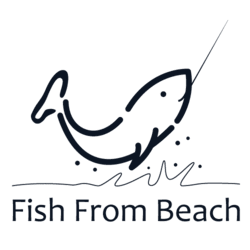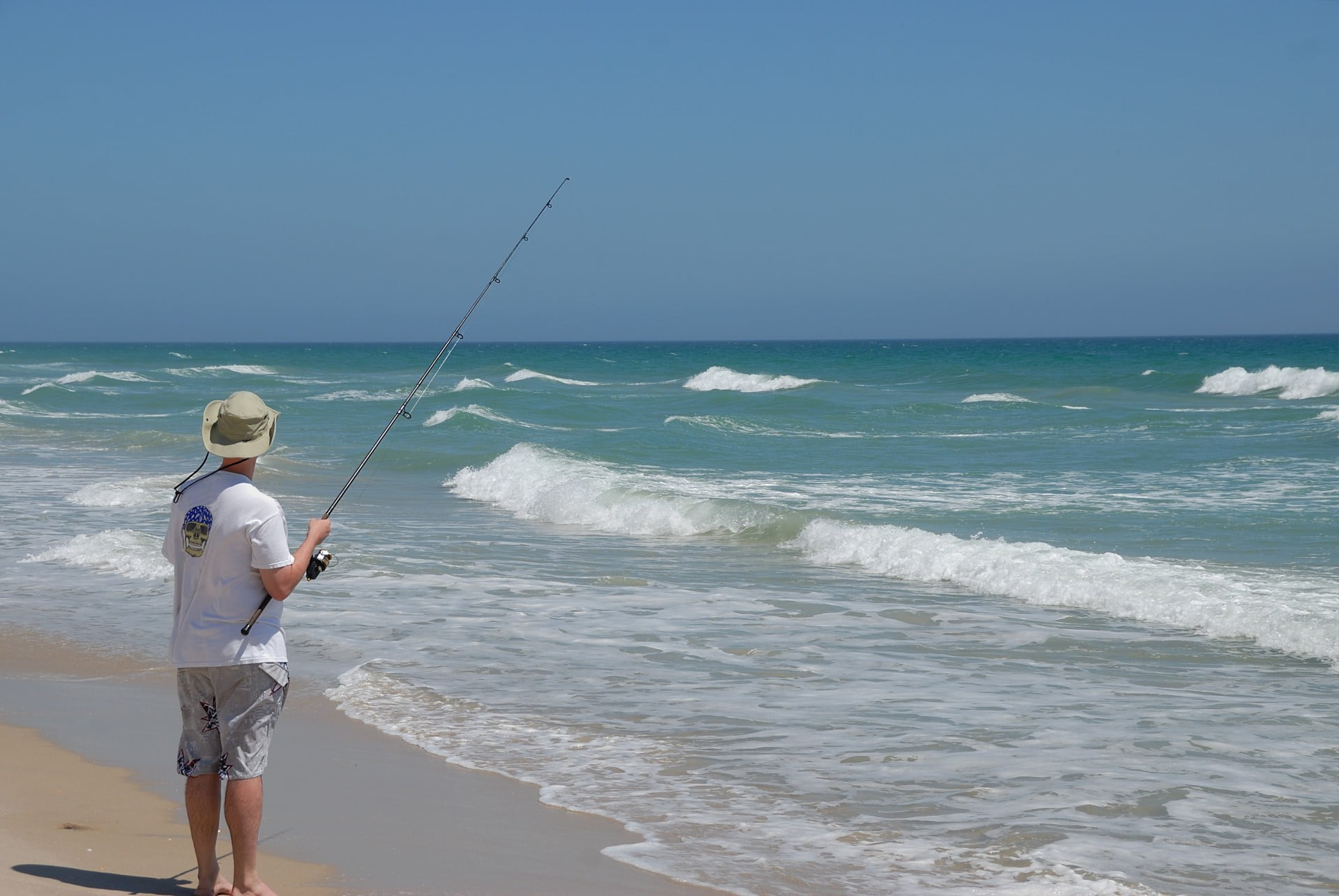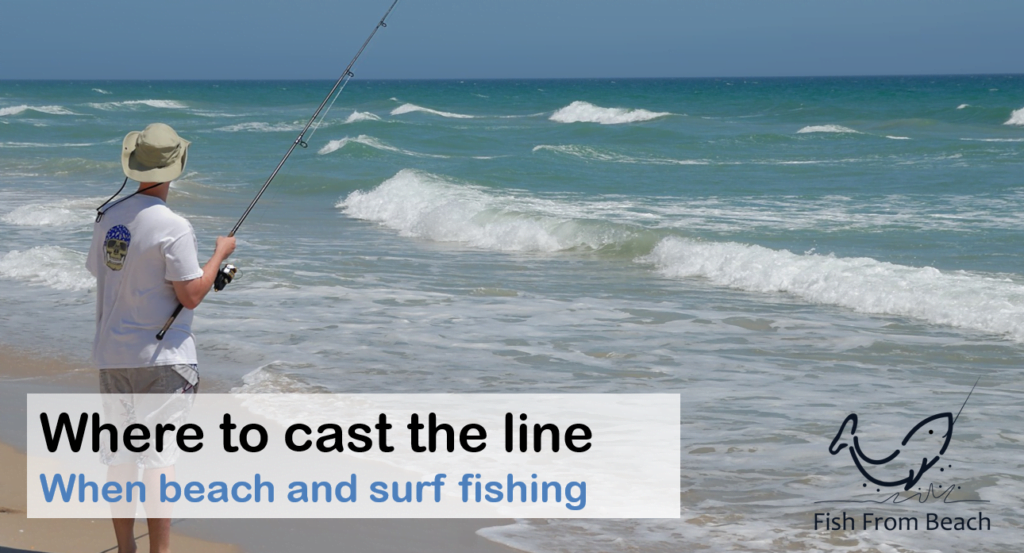
Surf fishing is most rewarding when you know where to cast the line and where to deploy your bait.
You may have the best tackle, you may be able to reach the furthest spots in the surf, and you may be lucky to fish in the hottest areas of the world, but if you don’t know where the fish hold and where to cast the line, then your productivity will certainly suffer.
As a rule of thumb, fish concentrate on particular zones in the surf, depending on the time of the day, the weather conditions, the surf conditions and the structure of the beach.
Being able to identify these zones accurately is an essential skill for anyone who wants to fish the surf.
So what’re the best spots to target when surf fishing ? And what’re the underwater structures where the fish concentrate and hold ?
Fish spend most of the time on the seaside and shore side of the sandbars, as well as in the deep waters that cut the sandbars where the rip current heads seaward and carries food elements to the open sea. This is where the small and medium-sized fish feel safe to swim and feed, and in turn, this is where the big predators look for food and prey.
In this article, we will learn how to accurately identify these spots and how to read the underwater structures to determine the optimal areas on which you should cast the line when shore fishing.
Why you must know where to cast the line when beach fishing ?
You need to know where to cast the line because otherwise, you will simply spend most of your day waiting for bites. And guess what ? they may never happen.
We all have the misconception that fish are homogeneously spread and distributed along the surf zone and that wherever we throw the bait, there should be some fish to spot it and eat it.
We also think that the deeper the water is and the further we go in the surf, the bigger the fish we catch.
These two ideas can’t be further from the truth…
Fish are extremely cautious and suspicious creatures. As a result, they will only be where it’s safe to hold and feed, and if they feel the slightest danger, they start to stress and move to another area.
That’s why you should never expect to find fish wherever you cast the bait.
In fact, you should be more pessimistic about this and consider most surf spots to be empty and deserted.
What ? So why do I keep catching fish even if I cast the line randomly without targeting a specific area ?
Well, the chances that a fish smell your bait from distance and come eat it are extremely slim. Fish near the shore will only eat when food is nearby and will rarely venture for distant food.
Only big predatory fish will be able to search for food along the surf and follow the smell of your baits wherever you deploy them. But this is a rare case and you should not take it as a general rule.
The general rule is that the nearshore fish will only eat when the food is nearby.
That said, the next time you randomly cast the line and still catch fish, you should celebrate your luck because your bait was deployed exactly where the fish hold.
What to look for when beach fishing ?
Now that we understand why it is necessary to know where to cast the line when beach fishing, let’s dive deeper into the subject and learn where the fish prefer to swim and feed.
All the beaches of the world are made up of 3 structures :
The sandbars : The sandbars or sandbanks are bars of sand or coarse sediment that form underwater and run parallel to the shoreline. As a general rule, on any beach, you should find 2 to 3 sandbars separating the shore from the open sea.
The troughs : the troughs or the sloughs are the hollows or deep waters between 2 sandbars.
The channels : The channels are the openings that break the sandbars allowing a current (The rip current) to run out to the open sea.
In general, all you need to do is to identify the sandbars. Once you find them, it will be easier to guess where the troughs and channels are.
Ok, how to identify the sandbars ?
The sandbars can be revealed by the white waters that form once the breaking waves rollover above them.
The white waters indicate that there is a bump in the underwater terrain which forces the waves to rise and crash.
Once you locate the sandbars, look for the deep and dark waters between the first and second sandbar. These are the troughs.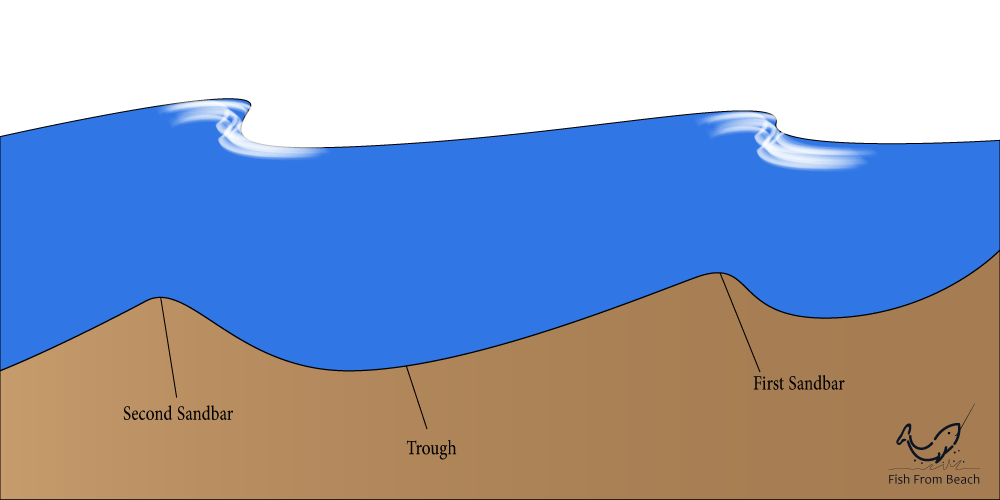
And finally, look for the openings that break the whitewater to identify the channels.
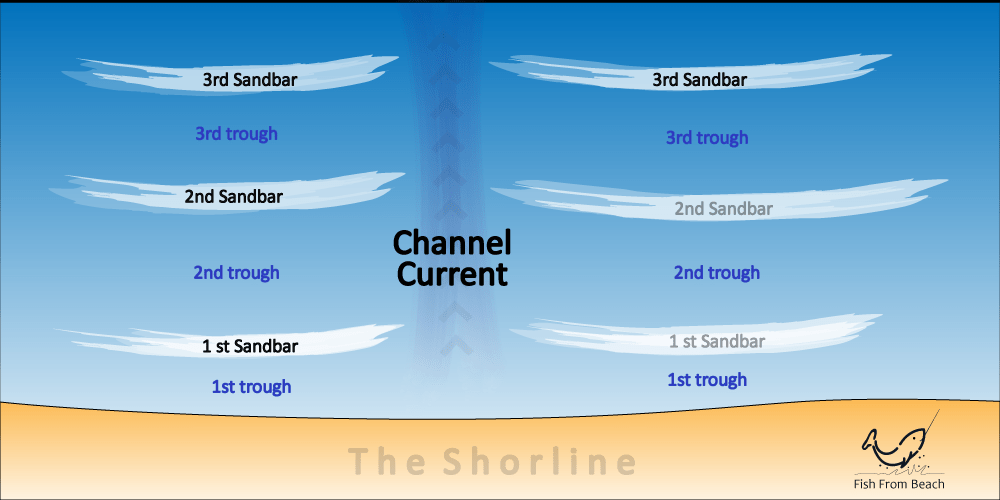
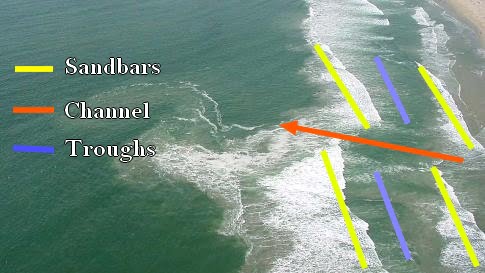
Don’t worry if you fail to do all this. As a novice fisherman, you may find it difficult to identify these structures. However, with a little experience and practice, you will be more familiar with the underwater topology and the main structures of any beach or surf.
Scouting the beach at low tide is also a good idea as the water fall can reveal and expose the underwater structures, giving you more opportunity to see exactly where the troughs and sandbanks are.
Target the edges of the sandbars
The shore side and seaside of a sandbank are where the nearshore fish feel comfortable to hold and eat. Why ? because as the waves rise and rollover, the water becomes muddy and colorful, making it easy and safe for small fish to hide and feed.
In turn, the bigger predators use this water turbulence as a cover to surprise and trick unwary prey.
Another reason why fish prefer to stay where the waves crash is that the water turbulence stirs up and exposes more nutrients on the sea bed such as the sand fleas, the crabs, and the mussels.
On top of that, the moving waters around the sandbars make it difficult for small baitfish to escape predators, hence catching them becomes a less energy-consuming task.
As a result of all that, both large and small fish will hold and concentrate along the edges of sandbars, and thus, this is where you need to cast the line when beach fishing.
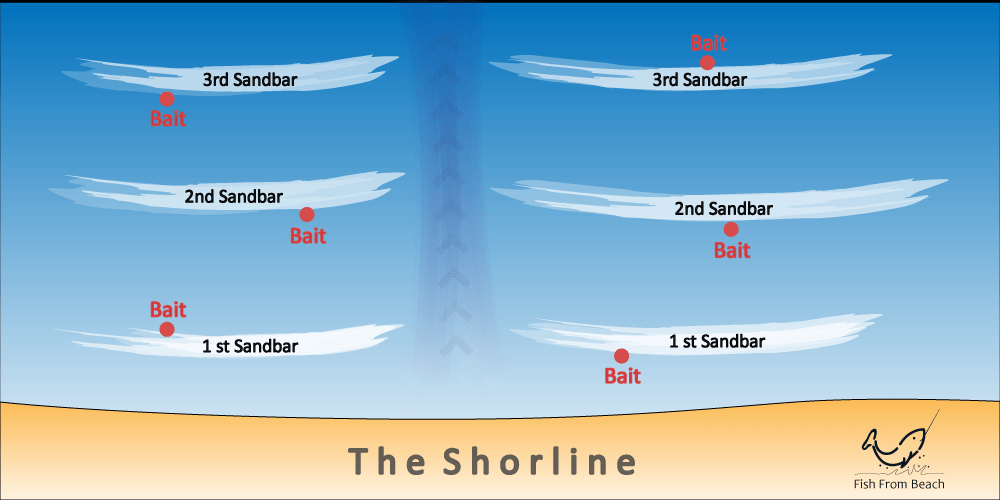
The reason why I insist on targeting the edges of a sandbar and not the top of it is that at the top, the water may be too shallow, and this is not safe for most fish species.
However, if the tide is high and the sandbars are deep, then placing the bait on the top would not be a bad idea.
One last thing about the sandbars is that the way the waves rollover and crash says a lot about the characteristics of the submerged sandbars.
When the white water softly crumbles over a long distance, it means that the drop-off between the sandbar and the trough is gradual and progressive.
This generates more turbulence and cover and allows the fish to spread and feed on a wider surface, maximizing your chances of catching something.
On the other hand, when the cut-off between the white and the blue water is sharp and clear, it means that it’s a steep sandbar underneath.
In this case, you should be more accurate when casting the line, as it will be harder to place the bait exactly on the edges of the sandbar.
Target the channel
The channels are also a great place to deploy baits, especially when targeting large fish such as the stripers, the blues, and the sharks…
Inside the channel, a strong current (the rip current) heads offshore and carries with it all the food, baits, and nutrients left on the shore and the troughs between the sandbanks.
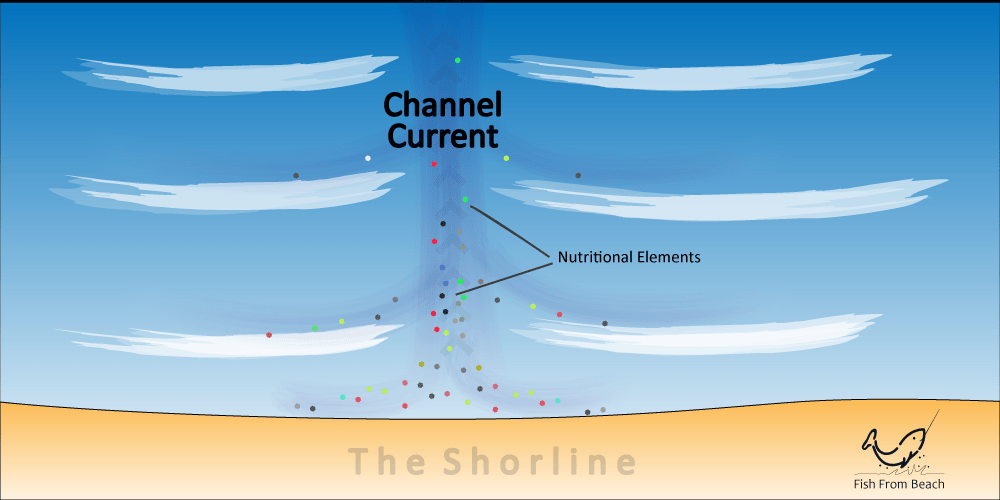
As a result, the large predatory fish living offshore will often approach the shoreline via this channel in search of the carried food, and thus, you should be there placing your offering and waiting for them.
What I like the most about targeting the current between the sandbars, is that when a bite occurs, I can be pretty sure that It’s a big fish. Why ? because small or medium-sized fish would rarely swim inside the channel.
It’s not a safe place, and no small fish want to be there.
Only the large predatory fish are able to use these channels in order to approach the shore and feed on the nutrients carried by the outgoing current and the baitfish holding on the sandbars edges.
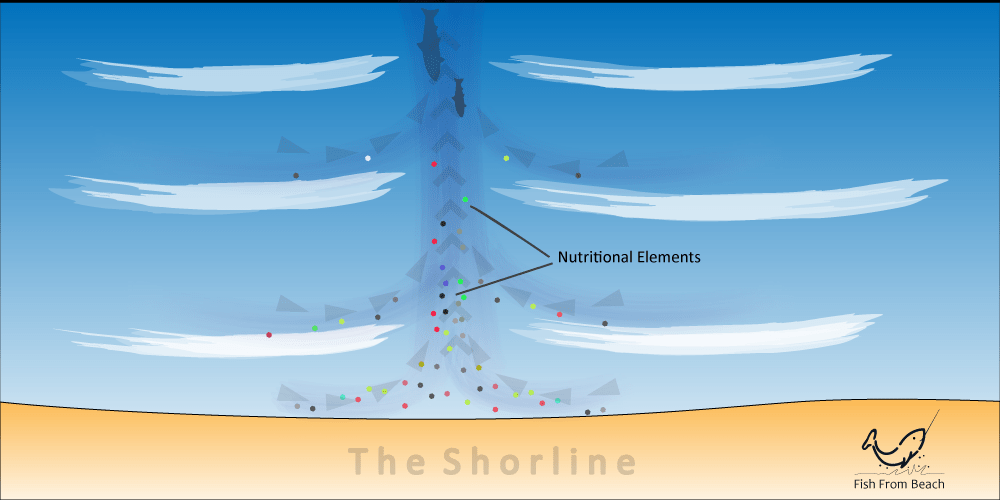
On top of that, the outgoing current inside the channel will often pull your baited rig seaward, increasing your casting distance.
That being said, keep in mind that you should consider the use of a heavy line when casting into the current.
The fish you may catch there can weigh more than 30 pounds, and as a result, you should use the appropriate pound test.
Read this article where we discussed the optimal line weight for surf fishing.
In addition, a thicker line will receive more pressure from the current and will be pulled further taking your bait to places you can never reach by simply casting the rod.
Avoid the troughs
The water between sandbars is generally deep and clear, and this is unsafe and dangerous for small and medium-sized fish.
As a result, most fish species will try to avoid the trough. Why ? Because for the small fish, it exposes them and makes them more visible to the larger predators, while for the bigger fish, it does not provide enough cover when looking for prey.
That’s why you should avoid targeting the troughs. Your chances of catching something there are slim.
The only case where I would target the troughs is when the current is too strong. Why ? Because when the water is moving, it can bring your bait closer to the channel, and as a result, a hungry fish looking for food in the rip current may smell it, get into the trough and eat it.
A strong current can also carry the nutrients deposited on the sandbars to the bottom of the troughs, and thus, it is possible to find some fish (generally sizeable fish) feeding there.
Read more tips on how to surf fish strong currents.
One last point about the troughs is that you should always try to target the seaside of the sandbars. Why ? because if you deploy your bait on the shore side, It is likely that the wave action pushes it towards the trough and this is not where you want to be.
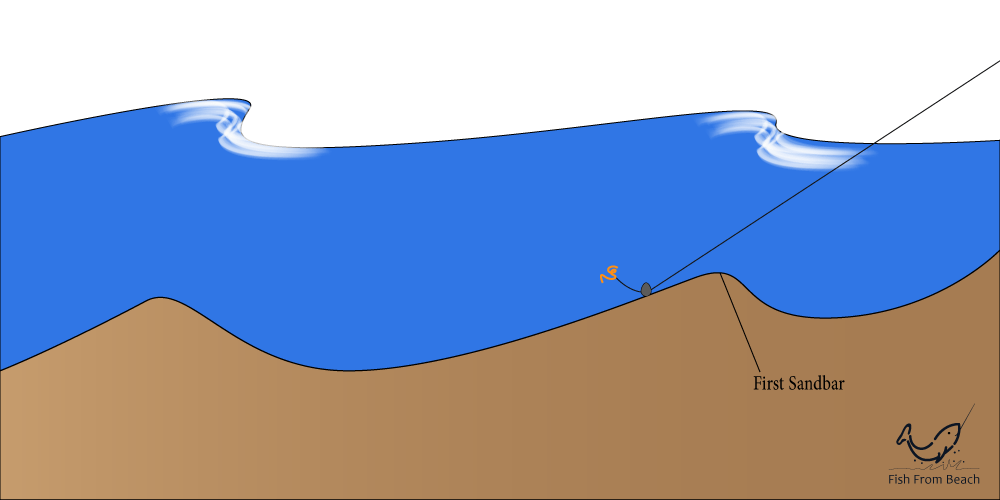
Try to deploy baits on the sea side of the sandbar so the waves don’t push it towards the trough
To do so, try to cast the line just before where the white waters start to form and use enough casting weight so the lead sinks quickly, and resist well against the current.
Generally speaking, a 3-4 oz sinker is enough for most surf conditions, but if the current is too strong, using 6-8 oz leads won’t be a bad idea.
Read this article about the best weight for surf fishing for more information.
The Sweet Spots
With all that we learned in this article, we can finally conclude that the sweet spots where to cast the line when shore fishing are the extreme sides of the sandbars.
By targeting the extreme sides of the sandbars, you place the offering on the bars where the small and medium-sized fish feel comfortable to hold and eat, but also near the channel, where the big players look for prey and baitfish.
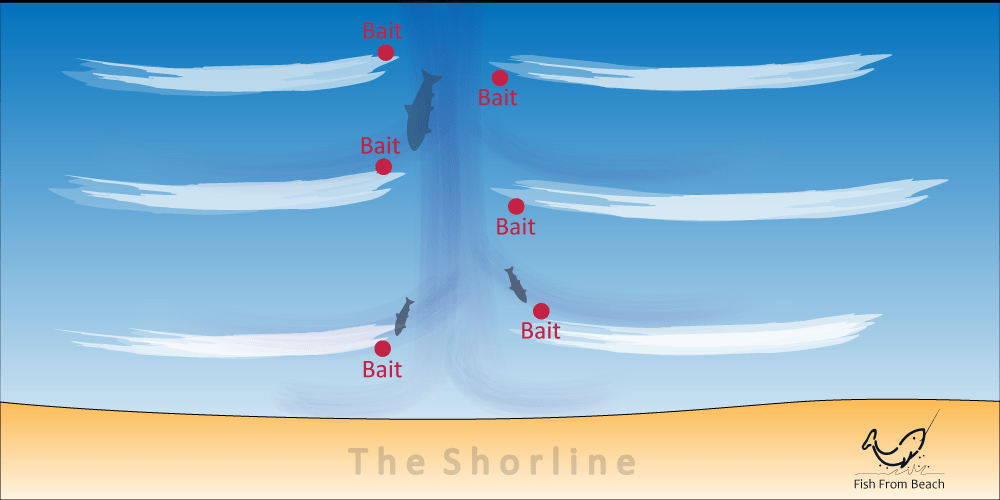
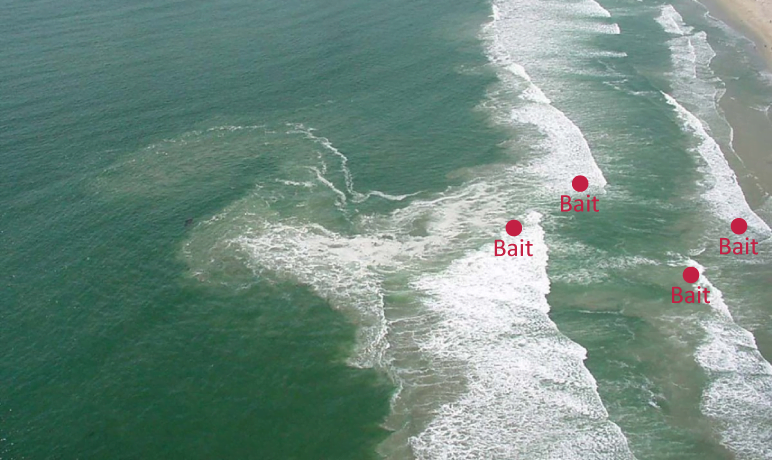
However, and as discussed earlier, I would never target the sides of the sandbars if I don’t have the appropriate pound test.
As we said earlier, heavy big predators may be in the channel looking for food, and you don’t want a 50-pound striper to strike your 10 lb test line.
Should you cast far when beach fishing ?
Well, based on what we discussed in this article, it’s obvious that the only case where you should cast far is when targeting the rip current inside the channel.
When casting into the channel, you want your bait to be the first thing that fish encounter as they approach the shore. In this case, Yes it is beneficial to reach the furthest spots possible.
But when casting in the direction of the sandbars and the troughs, I see no benefit in casting far. Why ? because the further you go, the less accurate your casts will be, and consequently, you may put the bait in a trough, which, as we said, is not optimal for surf fishing.
On top of that, there is no evidence that the fish holding on the third sandbar are bigger than the ones holding on the first or second bars.
Unless you are over 300 yards from shore, the fish holding in the surf zone tend to be homogeneous in size.
Both 3-inchers and 25-inchers can hold on the same sandbar.
So, why cast far and sacrifice accuracy when you can catch the same size of fish a few yards from shore?
Another case where you may need to cast far is when the beach is crowded and when many people are swimming near the first and second sandbars.
In this case, fish will likely escape into deeper waters, and you should probably try a longer casting distance in order to get them.
A low tide may also force you to cast far in order to reach deep waters.
Final Thoughts
The beach is a great place to catch fish. However, the amount of fish you catch depends on many factors : the tide, the weather, the current, the tackle, the moon phase, the surf conditions…etc.
Most of these variables are unpredictable and uncontrollable, and no one can blame you if you do not catch fish on an extremely windy day or when the tide is low.
However, you are the one to blame if you do not ensure the other things that are within your control circle, such as the equipment you use, and where you cast the line.
These are factors that you can totally control, and you don’t have the right to miss catches because of a bad tackle or a wrong casting direction ;).
So, prepare the right tackle box, hit the beach, read the underwater structures, identify the sandbars and the channels, and throw in your delicious bait.
Some recommended surf fishing gear(*)
Note (*): If you make a purchase through links from this website, we may get a small share of the sale from Amazon or other similar affiliate programs.
Surf Fishing Survey
Help us provide you with better content by answering simple questions about your surf fishing experience and knowledge.
We will put the collected responses together and turn them into valuable information that will help you catch more fish from shore 😉
Note: No personal information will be collected with your answer.
